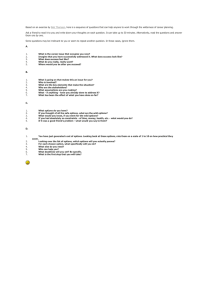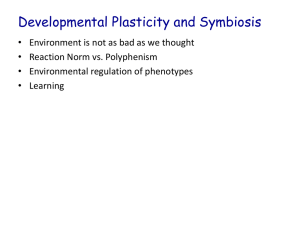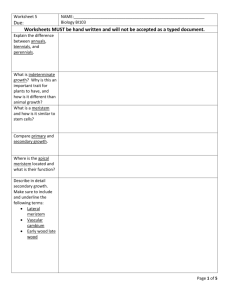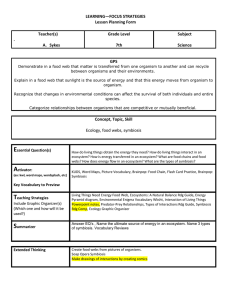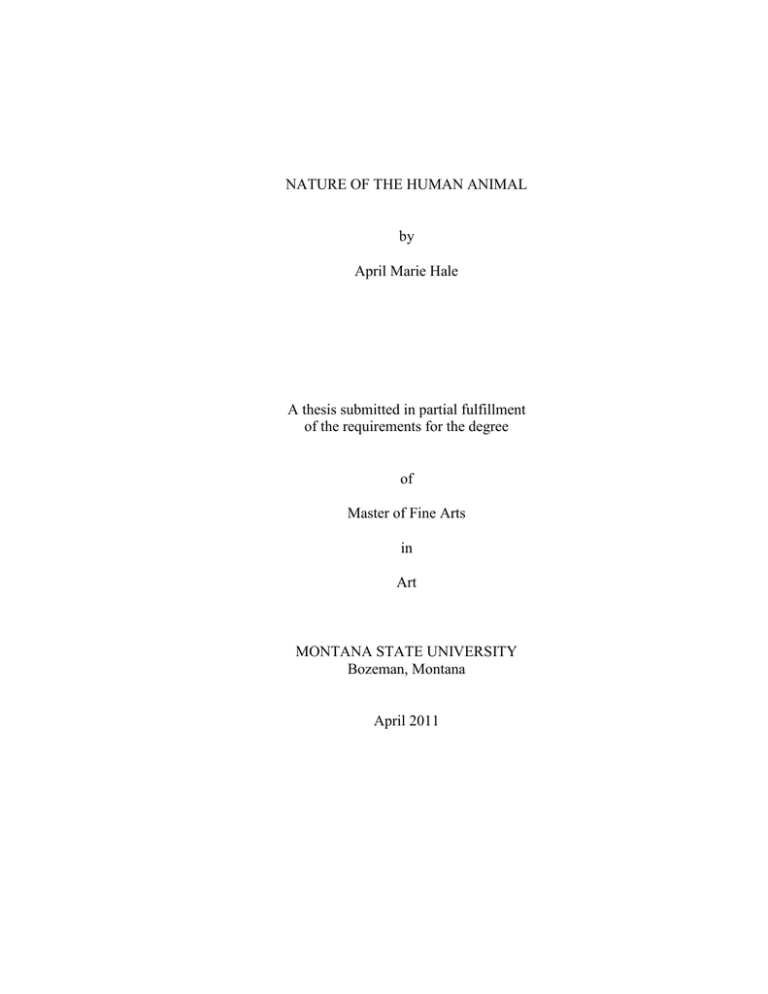
NATURE OF THE HUMAN ANIMAL
by
April Marie Hale
A thesis submitted in partial fulfillment
of the requirements for the degree
of
Master of Fine Arts
in
Art
MONTANA STATE UNIVERSITY
Bozeman, Montana
April 2011
©COPYRIGHT
by
April Marie Hale
2011
All Rights Reserved
ii
APPROVAL
of a thesis submitted by
April Marie Hale
This thesis has been read by each member of the thesis committee and has been
found to be satisfactory regarding content, English usage, format, citation, bibliographic
style, and consistency and is ready for submission to The Graduate School.
Bryan Petersen
Approved for the Department of Art
Vaughan Judge
Approved for The Graduate School
Dr. Carl A. Fox
iii
STATEMENT OF PERMISSION TO USE
In presenting this thesis in partial fulfillment of the requirements for a master’s
degree at Montana State University, I agree that the Library shall make it available to
borrowers under rules of the Library.
If I have indicated my intention to copyright this thesis by including a copyright
notice page, copying is allowable only for scholarly purposes, consistent with “fair use”
as prescribed in the U.S. Copyright Law. Requests for permission for extended quotation
from or reproduction of this thesis in whole or in parts may be granted only by the
copyright holder.
April Marie Hale
April 2011
iv
LIST OF IMAGES
Images
Page
1. Symbiosis Necklaces (Installation View) ..........................................................12
2. Symbiosis Necklace (wild licorice and deer).....................................................13
3. Symbiosis Necklace (cottonwood and iris)........................................................14
4. Symbiosis Necklace (horsehair and clematis) ...................................................15
5. Symbiosis Necklace (willow and milk vetch) ...................................................16
6. Symbiosis Necklace (milk vetch and leafcutter bees) .......................................17
7. Symbiosis Necklace (deer and needle and thread grass) ...................................18
8. Symbiosis Necklace (raccoon, cow parsnip, and moose) ..................................19
9. Symbiosis Necklace (alder and wheat) ..............................................................20
10. Symbiosis Necklace (deer and blazing star) ....................................................21
11. Sown Seeds ......................................................................................................22
12. Sown Seeds (Detail) .........................................................................................22
13. Dormancy: Cow ...............................................................................................23
14. Dormancy: Cow (Detail)..................................................................................24
15. Reproduce ........................................................................................................25
16. Seedhead/Seedbed Brooches (Installation View) ............................................26
17. Seedhead/Seedbed Brooch: Goat’s Beard .......................................................27
18. Seedhead/Seedbed Brooch: Goldenrod............................................................28
19. Seedhead/Seedbed Brooch: Needle and Thread Grass ....................................29
20. Seedhead/Seedbed Brooch: Foxtail Barley ......................................................30
v
LIST OF IMAGES – CONTINUED
Images
Page
21. Seedhead/Seedbed Brooch: Dandelion ............................................................31
22. Growth: Sage ...................................................................................................32
23. Brucellosis Graft ..............................................................................................33
24. Dormancy: Deer ...............................................................................................34
25. Dormancy: Deer (Detail) .................................................................................35
26. Spilling Seed ....................................................................................................36
27. Spilling Seed (Detail) .......................................................................................37
28. Transplant: Goat’s Beard and Hawthorn .........................................................38
29. Transplant: Goat’s Beard and Hawthorn (Detail) ............................................38
30. Symbiosis Necklaces, Growth: Sage, and Taking Root (Installation View) ...39
31. Taking Root .....................................................................................................39
32. Taking Root (Detail) ........................................................................................40
33. Symbiosis Brooches (Installation View) .........................................................41
34. Symbiosis Brooch: Deer and Needle and Thread Grass ..................................42
35. Symbiosis Brooch: Wood and Deer .................................................................43
36. Symbiosis Brooch: Raccoon and Buttercup ....................................................44
37. Spreading Seed.................................................................................................45
38. Sown Seed Brooches and Growth: Cattails (Installation View) ......................46
39. Sown Seed Brooches........................................................................................46
40. Sown Seed Brooch: Bones ...............................................................................47
vi
LIST OF IMAGES – CONTINUED
Images
Page
41. Sown Seed Brooch: Iris ...................................................................................48
42. Sown Seed Brooch: Buttercup .........................................................................49
43. Sown Seed Brooch: Turtle ...............................................................................50
44. Growth: Cattails ...............................................................................................51
45. Potential for Growth ........................................................................................52
46. Potential for Growth: Foxtail Barley ...............................................................53
47. Potential for Growth: Buttercup.......................................................................54
48. Transplant: Porcupine and Wild Licorice ........................................................55
49. Transplant: Porcupine and Wild Licorice (Detail)...........................................55
50. Masticate ..........................................................................................................56
51. Potential for Growth, Transplant: Porcupine and Wild Licorice, Dormancy:
Deer, Spilling Seed, Transplant: Goat’s Beard and Hawthorn, Symbiosis
Necklaces, Growth: Sage (Installation View .........................................................57
52. Sown Seeds, Reproduce, Dormancy: Cow, Seedhead/Seedbed Brooches,
Growth: Sage, Sown Seed Brooches, Growth: Cattails (Installation View)..........57
53. Sown Seeds, Reproduce, Dormancy: Cow (Installation View) .......................58
54. Brucellosis Graft, Growth: Cattails, Dormancy: Deer, Spilling Seed,
Transplant: Goat’s Beard and Hawthorn (Installation View) ................................58
55. Symbiosis Brooches, Spreading Seed (Installation View) ..............................59
56. Growth: Sage, Potential for Growth, Transplant: Porcupine and Wild Licorice,
Dormancy: Deer, Spilling Seed (Installation View) ..............................................59
vii
ABSTRACT
Similar to a mad scientist, I combine materials that are not connected in nature.
Joining seeds with animal parts or other plants is symbolic of the symbiosis of all beings.
Seeds represent growth, death, reproduction, and interdependence. The softness and
fragility of much of the work makes the viewer aware of her/his own body and breath.
The air we inhale is the exhaled breath of other beings. The frontiers between us and
them and wild and civilized are human constructs.
I question my relationship with the wilderness. How much am I part of the landscape,
and how much do I distance myself from it? Using materials from the local environment
is a way to become familiar with the life cycle and the spaces in which I live. I work
intuitively, responding to the materials – the way seeds attach to clothing or the bending
of willow determines the structure of the finished pieces.
The combination of linear structure (taking root and transplants) and plants that seem
to grow out of the wall (growths) creates a contrast between what we see as human and
natural order. There is an irony to the growths – they are transformed as much as the
linear work in that I have brought them into a human-constructed environment and
arranged the plants in a pattern influenced by my perception of wilderness.
The adornment and sculpture that comprise Nature of the Human Animal are fragile,
on the verge of decomposition, but simultaneously carry the potential to renew life
through the seeds from which they are constructed and the decomposition that threatens
the integrity of the work. Death does not remove life from the world: every end is also a
beginning.
The physical connection between the viewer and the materials is enhanced by the
concept of adornment. We express our beliefs and personalities through what we wear.
The viewers can imagine themselves or others wearing the objects, thus seeing the work
in an active, sensual, and personal context. My hope is that this will lead to a
consideration of the viewer’s relationship to the materials and the landscape.
1
I frequently question my relationship with the wilderness. How much am I part of the
landscape, and how much do I avoid interacting with the landscape? I negotiate this
interdependency by questioning my ideas of death, life cycles, order, even spirituality
(which is ultimately related to the previous concepts). The adornment and sculpture that
comprise Nature of the Human Animal are fragile, on the verge of decomposition, but
simultaneously carry the potential to renew life through the seeds from which they are
constructed and the very decomposition that threatens the work.
Joining seeds with animal parts or with other plants is symbolic of the symbiosis of
all beings. Seeds represent the need for humans to reinvest ourselves in our environments
and act as a metaphor for the impact humans have on earth – the movement of seeds in
the gallery is symbolic of our ability to change our environments through our actions. I
forcibly connect materials that are not normally seen as correlated, such as bone and
seed; but by nature these materials are connected because we are all made of the same
substances, breathe the same air, come from the same earth. The softness and fragility of
many of the pieces creates awareness in the viewer of her/his own body and breath. The
air we inhale is the exhaled breath of other beings. The frontiers between us and them,
wild and civilized, alive and dead are human constructs.
In his book, The Practice of the Wild, Gary Snyder asks the question “where do we
start to resolve the dichotomy of the civilized and the wild?” (16). Humanity have for
thousands of years been distancing ourselves farther and farther from the wilderness, to
2
the degree that many do not even feel comfortable in the outdoors. It seems to be an
innately human trait to separate the self from the rest of earth, but we need wildness to be
whole. As an artist I must deal with the fact that my interpretation of the landscape may
distance me from the wild as much as it connects me to the wild. Can we find that
tenuous place in which we can be both active participants in our society and in the wild,
or does the definition of wild ultimately negate human interaction?
I feel a need to try to experience the landscape in a reciprocal way, as opposed to the
view that the wilderness is here for our use and exploitation. I do not take more than I can
give, and I try to believe in the intelligence of other beings. You could say that I believe
in magic. Joining seeds with animal parts or with other plants is magical because the act
questions our ideas of interdependency and embraces the complicated relationships
among the animate world. Magic can be defined as that which is beyond our
understanding, that which we cannot control, and that which is outside our means of
verbal communication. The role of the shaman in a community is to serve as an
intermediary between the human and natural worlds. This is why the shaman is magical
– she/he can communicate with the wild in ways that most members of society cannot
and accepts a lack of control over these relationships. In many ways, the artist serves a
similar purpose in her community as the shaman. We try to communicate with our
audience that which is not easy to reconcile or understand.
It is important that I use organic, decomposable, and locally gathered materials. These
items, which come from our local ecosystem, will go back into the environment, thus
continuing to contribute to the life cycle. As in my life practices, I attempt to approach art
3
with the idea that I negatively affect the ecosystem as little as possible while still
communicating with my audience. The goal is not that my work last forever in the state it
is in now; rather, the goal is that the work continue to be a part of the cycle of life and
death. In the case of native plants, I harvest only what I need to ensure that I do not take
more than the system can give without negatively impacting future growth.
Most of the materials used in this show come from animals or plants which are
dead. The adornment and sculpture are impermanent– they will decompose and return to
the life cycle. Death does not remove life from the world. Every end is also a beginning:
the potential for life is always present at death. Likewise, death does not remove life from
the materials – the animate materials have a life of their own. Seeds and bones symbolize
both death and the potential for life to exist again. On the other hand, we also must face
mortality if we are to accept our role in the life cycle. As humans we feel that we are
apart from everything else, but when we die, we do not stop existing. We merely begin
interacting with our environment in a different way. As our bodies deteriorate (if we let
them), we give life to other beings. All life is made from the same elements, so can we
really be so separate?
We [humans] are more than we seem at first sight, our body
surfaces define us significantly but never totally. We are constructed or
composed externally, internally, physically, mentally, spiritually and in
every other way for relationships. Our individuality is communal. It is
always both embodied and corporate…; intensely private, personal, and
unique and also immediately shared and relational. All of this is before we
utilize our breath, the shared air, and our embodiment, to speak and listen,
to perform these acts is to enact our personhood (Harvey 44).
4
The combinations of seemingly disparate elements, such as cattail seeds and a
goat scrotum in spilling seed, symbolize the fact that although these parts come from
different species, they are ultimately parts of the same whole – that of the entire being of
earth. So many of our actions result from a desire to preserve our own species or to
preserve other species for our own use/benefit, but such anthropocentrism does not
consider the preservation of the entire ecosystem for its own sake. “Whatever sense of
ethical responsibility and concern that human beings can muster must be translated from
a human-centered consciousness to a natural systems-wide sense of value” (Snyder, A
Place in Space 210).
Humans often romanticize wilderness – now that we have distanced ourselves from
wilderness, we sometimes feel that to “go back to the land” would be simpler and easier
than our current complicated culture (Tuan 111). In a way, I feel that this romanticism is
necessary in the development of our understanding of wilderness and our relationship
with it. Romanticism can help people in their understanding of and sensitivity to their
relationship with the wild by bringing emphasis to our awareness of our own role in
space. The process of distancing ourselves from and bringing ourselves back to an
understanding of our relationship with wilderness is cyclical, much like all life and
interactions. Perhaps it is necessary to first contextualize and understand the wild by
shaping it into a recognizable and interpretable symbol. In beginning to understand
wilderness in human terms, perhaps we are led to an understanding of wilderness on wild
terms. The combination of linearly arranged pieces (taking root and the transplant series)
and plants that seem to organically grow out of the wall (growths series) creates a
5
contrast between what we see as human order and a natural order that we may not
perceive. There is an irony to the growths – they have been transformed as much as the
linear work in that I have brought them into a human-constructed environment and placed
them on the wall in what may seem to be a natural pattern, but is still an order
constructed by the human hand, and thus influenced by my perception of wilderness. We
often attempt to order that which we do not understand. The linear horsehair stitching and
the random distribution of seeds on felted wool, exemplified by the sown seeds series,
create layers of seemingly natural order and constructed order. This aesthetic is carried
through to the growths – this series replicates the felted works on a larger scale, the wall
replacing the felt. In the end, even the felted wool, which may seem to lack order, is
constructed in an orderly fashion.
There is a fragility and ephemerality to my work, much as our relationships, our
being, and our presence are all fragile and ephemeral. These materials are meant to
decompose, to again return to the earth. Our tenuous relationship with our environment,
while seemingly controlled by us, can easily be permanently changed by geological and
ecological forces. Even the very human idea of permanence comes into question in the
scale of geologic time. Also, linear time makes so much less sense when viewed from the
perspective of humanity as part of a life cycle or an infinite, ever-changing universe.
“The actualization of the spiritual and political implications of ecology…must
occur place by place” (Snyder, A Place in Space 79). The more we experience the spaces
in which we live in as many ways as possible, perhaps we will be compelled to protect
those landscapes and all of their inhabitants, because we will realize that we cannot exist
6
without them. What is more wholesome – to be part of a human-constructed society
filled with human-constructed gadgets, only seeing our surroundings on human terms; or
to be part of the entire earth, going about our interactions with our environment with
regard to the welfare of all beings? “This shadowed, earthly world of deer tracks and
moss… is more palpable to my skin, more substantial to my flaring nostrils, more
precious- infinitely more precious – to the heart drumming in my chest” (Abram 6). In
respecting wild areas and native spaces, we are ultimately taking care of ourselves.
In all of the work, I empathize with materials that many may see as inert, but that
I see as animate. I work intuitively, responding to the materials – the way seeds attach to
clothing or the bending of willow determines the structure of the finished pieces. “One
cannot enter into a felt rapport with another entity if one assumes that that other is
entirely inanimate. It is difficult, if not impossible, to empathize with an inert object”
(Abram 44). Adornment is an important vehicle for my work because of the physical
connection that is created between the human and the worn materials. We frequently see
clothing and jewelry as visual representations of ethics, opinions, and personality.
Adornment, more than sculpture, creates an empathy with the materials. The viewers can
imagine themselves or others wearing the objects, thus considering the work in a very
active, sensual, and personal context. My hope is that this will lead to a consideration of
the viewer’s relationship to the materials and the landscape.
Could we…identify ourselves with things in some sense more distant and
more alien – creatures of the wild, members of other species, life forms
like rivers and mountains? Identification with the wild Other is precisely
what may allow wild things to be saved…. If empathy and the sense of
7
self can be extended beyond our identification with human groups to the
natural world, perhaps we can stop destroying nature (Nicholsen 49).
The adornment and sculpture in my work ask the viewer to do just this – to form a bond
between her/himself and the wild. Not only the wildness of the Other, but the wildness in
the self. “The wild outside – wilderness – matches and is matched by the wild inside, the
deeper levels of the mind and spirit and body” (Nicholsen 44). We thus come to know
ourselves through knowing the Other.
In the process of creating and exploring my environment, I have developed an
interest in and respect for animistic religions. “Animism is a view of the world as a place
shared by all living beings that stands in radical contrast to a view that (falsely) only
perceives exploitable environments and resources” (Harvey 27). The process of
exploration and creation has helped me to realize a spirituality that I did not fully
understand or acknowledge. I now consider my relationship to the greater world and my
role in it in a way I did not previously. The quietude and softness of the work parallels
the feelings I often have when quietly interacting with the wilderness. I grew up using
dead bugs, rocks, sticks, and animal parts as playthings and art materials. In a way, I am
using the same materials I did as a child, but the work has a consciousness, maturity, and
intent that it did not have previously. Using materials from the local environment is a way
to familiarize myself with the landscape in which I am living, one vastly different from
the Tennessee landscapes in which I was raised. This exploration of materials and spaces
is a type of spiritual exploration, influenced by animism, that has led to an awareness of
my role in the life cycle and local landscape. “Religion is not centrally a ‘belief in the
8
supernatural’…but is ‘a quest for ethical responsibility through communicative action’”
(49).
Directly related to animistic concepts and my ideas concerning our interactions
with the world around us are theories of ecophenomenology and deep ecology developed
by David Abram, Erazim Kohak, Gary Snyder, and others. Deep ecology supports the
idea that we should respect all beings on earth equally, while ecophenomenology is the
idea that we can only really be connected to the wild through experience, not mere
material. We “must approach nature anew, undertaking no less than a phenomenology of
nature as the counterpart of our moral humanity….We need to suspend for the moment,
the presumption of the ontological significance of our constructs, including our
conception of nature as material, and look to experience with a fresh eye, taking as our
datum whatever presents itself in experience” (Kohak 22).
Parallel, but also perhaps contradictory, to the influence of the deep ecology and
ecophenomenology movements, dominated by males, is the influence of my involvement
in the late 1990’s and early 2000’s in feminist activism. Feminist philosophy is rife with
theories about the way our patriarchally structured society holds linear, logical thought
superior to intuition and cyclical thought. Ecofeminist theory specifically correlates the
oppression of women in patriarchal societal structures and the blatant disregard for and
exploitation of the environment – we can hold power over and use the environment
however we like because we don’t believe that it has rights or is sentient. “By
documenting the poor quality of life for women, children, people in the Third World,
animals, and the environment, ecofeminists are able to demonstrate that sexism, racism,
9
classism, speciesism, and naturism are mutually reinforcing systems of oppression”
(Gaard 5). The influence of these theories and my activism leads me to an ecofeminist
phenomenological approach.
Additionally, I am influenced by artists such as Joseph Beuys. In I Like America
and America Likes Me, Beuys spends eight hours in a gallery with a coyote, performing
various symbolic gestures and eventually achieving a connection and state of familiarity
with the coyote. The idea of bringing a wild being into a gallery and forcing it to interact
with a human carries over into my work. Although I am not performing in the gallery, I
am using seeds, animal parts, and adornment to symbolize similar connections and
familiarity with my environment. This refers back to the question of whether we can or
should view the wild according to a human order.
The jewelry and installation of Iris Eichenberg is influential in the way that she
blurs the boundaries between jewelry and sculpture. She combines sensuous materials
that superficially do not seem correlated into large, often difficult to wear pieces of
jewelry. The way she installs these pieces in the gallery then change our interpretation of
the work. We see them as both adornment and as sculpture. Eichenberg influences me not
only because of her aesthetic, but also because her jewelry is intended to cause sensual
reactions and to create connections among beings. In her body of work entitled Heimat,
Eichenberg explores the meaning and sense of life and the self, concluding that this sense
of self “can only… be found in the connections that every body, every self forges with
other bodies, other selves, as much as in the links between the body and its (im)material
others, whether in the form of other objects, other materialities, surrounding landscapes,
10
or even larger constitutive outsides” (“Tenement/Timelines”). Eichenberg also connects
her work to concepts of phenomenology. She sees her jewelry as extensions of the self
that reach out to others and create bridges for communication. This is what I am also
attempting, just with our relationship with the wild more than interpersonal relationships.
Viewers recognize unfamiliar relationships among the parts of my work, such as seeds
combined with wool in sown seeds, which brings into focus the derivation of the
materials and viewers’ relationships with them.
The way in which I order materials reflects my relationship with the wild. Will my
relationship with the wilderness ever be resolved, or will it continue to change, much as
the landscape itself is perpetually shifting and responding to environmental factors? Like
death, our role in the landscape is not clear or easily understood. Nature of the Human
Animal reflects the ambiguity of life – where there exists life, there also is death; where
there is humanity there is also wilderness. Perhaps there is no clearly definable line
between human society and wilderness, and I should embrace my interrelatedness with
the universe and the wilderness. As Gary Snyder said, “To resolve the dichotomy of the
civilized and the wild we must first resolve to be whole” (The Practice of the Wild 24). I
hope that my work will serve as the seed of a viewer’s relationship with the local
ecosystem and universe, in addition to influencing my personal growth as a human and
an artist.
11
WORKS CITED
Abram, David. Becoming Animal: An Earthly Cosmology. New York: Pantheon Books,
2010.
Eichenberg, Iris. “Tenement/Timelines.” Web. 16 March 2010.
<http://www.iriseichenberg.nl/eichenberg.html>
Gaard, Greta. “Living Interconnections with Animals and Nature.” Ecofeminism: Women,
Animals, Nature. Ed. Greta Gaard. Philadelphia: Temple University Press, 1993.
1-12.
Harvey, Graham. Animism: Respecting the Living World. New York: Columbia
University Press, 2006.
Kohak, Erazim. The Embers and the Stars. Chicago: University of Chicago Press, 1984.
Nicholsen, Shierry Weber. The Love of Nature and the End of the World: The Unspoken
Dimensions of Environmental Concern. Cambridge: The MIT Press, 2002.
Snyder, Gary. A Place in Space. Washington, D.C.: Counterpoint, 1995.
Snyder, Gary. The Practice of the Wild. Berkeley: Counterpoint, 1990.
Tuan, Yi-Fu. Topophilia: A Study of Environmental Perception, Attitudes, and Values.
Englewood Cliffs: Prentice-Hall, Inc., 1974.
12
Symbiosis Necklaces (Installation View) – Image 1
13
Symbiosis Necklace (wild licorice and deer) – Image 2
14
Symbiosis Necklace (cottonwood and iris) – Image 3
15
Symbiosis Necklace (horsehair and clematis) – Image 4
16
Symbiosis Necklace (willow and milk vetch) – Image 5
17
Symbiosis Necklace (milk vetch and leafcutter bees) – Image 6
18
Symbiosis Necklace (deer and needle and thread grass) – Image 7
19
Symbiosis Necklace (raccoon, cow parsnip, and moose) – Image 8
20
Symbiosis Necklace (alder and wheat) – Image 9
21
Symbiosis Necklace (deer and blazing star) – Image 10
22
Sown Seeds – Image 11
Sown Seeds (Detail) – Image 12
23
Dormancy: Cow – Image 13
24
Dormancy: Cow (Detail) – Image 14
25
Reproduce – Image 15
26
Seedhead/Seedbed Brooches (Installation View) – Image 16
27
Seedhead/Seedbed Brooch: Goat’s Beard – Image 17
28
Seedhead/Seedbed Brooch: Goldenrod – Image 18
29
Seedhead/Seedbed Brooch: Needle and Thread Grass – Image 19
30
Seedhead/Seedbed Brooch: Foxtail Barley – Image 20
31
Seedhead/Seedbed Brooch: Dandelion – Image 21
32
Growth: Sage – Image 22
33
Brucellosis Graft – Image 23
34
Dormancy: Deer – Image 24
35
Dormancy: Deer (Detail) – Image 25
36
Spilling Seed – Image 26
37
Spilling Seed (Detail) – Image 27
38
Transplant: Goat’s Beard and Hawthorn – Image 28
Transplant: Goat’s Beard and Hawthorn (Detail) – Image 29
39
Symbiosis Necklaces, Growth: Sage, and Taking Root (Installation View) – Image 30
Taking Root – Image 31
40
Taking Root (Detail) – Image 32
41
Symbiosis Brooches (Installation View) – Image 33
42
Symbiosis Brooch: Deer and Needle and Thread Grass – Image 34
43
Symbiosis Brooch: Wood and Deer – Image 35
44
Symbiosis Brooch: Raccoon and Buttercup – Image 36
45
Spreading Seed – Image 37
46
Sown Seed Brooches and Growth: Cattatils (Installation View) – Image 38
Sown Seed Brooches – Image 39
47
Sown Seed Brooch: Bones – Image 40
48
Sown Seed Brooch: Iris – Image 41
49
Sown Seed Brooch: Buttercup – Image 42
50
Sown Seed Brooch: Turtle – Image 43
51
Growth: Cattails – Image 44
52
Potential for Growth – Image 45
53
Potential for Growth: Foxtail Barley – Image 46
54
Potential for Growth: Buttercup – Image 47
55
Transplant: Porcupine and Wild Licorice – Image 48
Transplant: Porcupine and Wild Licorice (Detail) – Image 49
56
Masticate – Image 50
57
Potential for Growth, Transplant: Porcupine and Wild Licorice, Dormancy: Deer,
Spilling Seed, Transplant: Goat’s Beard and Hawthorn, Symbiosis Necklaces, Growth:
Sage (Installation View) – Image 51
Sown Seeds, Reproduce, Dormancy: Cow, Seedhead/Seedbed Brooches, Growth: Sage,
Sown Seed Brooches, Growth: Cattails (Installation View) – Image 52
58
Sown Seeds, Reproduce, Dormancy: Cow (Installation View) – Image 53
Brucellosis Graft, Growth: Cattails, Dormancy: Deer, Spilling Seed, Transplant: Goat’s
Beard and Hawthorn (Installation View) – Image 54
59
Symbiosis Brooches, Spreading Seed (Installation View) – Image 55
Growth: Sage, Potential for Growth, Transplant: Porcupine and Wild Licorice,
Dormancy: Deer, Spilling Seed (Installation View) – Image 56

